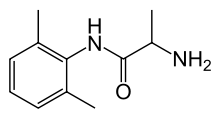Tocainide
Tocainide (Tonocard) is a class Ib antiarrhythmic agent. It is no longer sold in the United States.
 | |
| Clinical data | |
|---|---|
| AHFS/Drugs.com | Micromedex Detailed Consumer Information |
| MedlinePlus | a601248 |
| ATC code | |
| Pharmacokinetic data | |
| Bioavailability | 0.9-1 (oral) |
| Protein binding | 10-20% |
| Metabolism | glucuronidation (primary) |
| Elimination half-life | 9-14 R, 13-20 S |
| Excretion | 30-50% urine (unchanged) |
| Identifiers | |
IUPAC name
| |
| CAS Number | |
| PubChem CID | |
| IUPHAR/BPS | |
| DrugBank | |
| ChemSpider | |
| UNII | |
| KEGG | |
| ChEBI | |
| ChEMBL | |
| CompTox Dashboard (EPA) | |
| ECHA InfoCard | 100.050.441 |
| Chemical and physical data | |
| Formula | C11H16N2O |
| Molar mass | 192.258 g/mol g·mol−1 |
| 3D model (JSmol) | |
SMILES
| |
InChI
| |
| (verify) | |
Pharmacokinetics
Tocainide is a lidocaine analog, that does not have significant 1st pass metabolism. It is found in two enantiomers. The R isomer is 4x as potent as the S. Oral bioavailability is 0.9-1.0. In the blood tocainide is 10-20% protein bound. The Volume of distribution is 2.5-3.5 L/kg. 30-50% is excreted unchanged in the urine. The more active R-isomer is cleared faster in anephric patients or those with severe renal dysfunction. The main metabolite is the glucuronidated tocainide carbamic acid. The glucuronosyl transferase is apparently induced by rifampin. Weak inhibition of Cyp1A2 leads to a mild theophylline interaction. (Not verbatim)
References
- R.N. Boyes, E.W. Byrnes, DE 2235745 (1972).
- Astra Pharmaceutical Products Inc., GB 1461602 (1974).
- R.N. Boyes, B.R. Duce, E.M. Smith, E.W. Byrnes, DE2400540 (1974).
- Byrnes, Eugene W. (1979). "New antiarrhythmic agents. 1. Primary .alpha.-amino anilides". Journal of Medicinal Chemistry. 22 (10): 1171–1176. doi:10.1021/jm00196a005.
External links
Burton ME. Applied Pharmacokinetics & Pharmacodynamics: Principles of Therapeutic Drug Monitoring. 4th ed. Philadelphia: Lippincott Williams & Wilkins; 2006.
